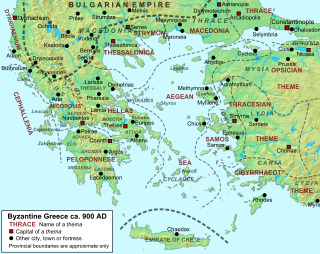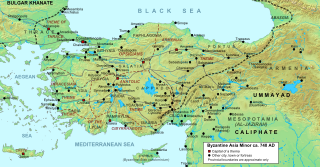
Theodosius III was Byzantine emperor from c. May 715 to 25 March 717. Before rising to power and seizing the throne of the Byzantine Empire, he was a tax collector in Adramyttium. In 715, the Byzantine navy and the troops of the Opsician Theme, one of the Byzantine provinces, revolted against Emperor Anastasius II, acclaiming the reluctant Theodosius as emperor. Theodosius led his troops to Chrysopolis and then Constantinople, the capital, seizing the city in November 715. Anastasius did not surrender until several months later, accepting exile in a monastery in return for safety. Many themes viewed Theodosius to be a puppet of the troops of the Opsician Theme, and his legitimacy was denied by the Anatolics and the Armeniacs under their respective strategoi (generals) Leo the Isaurian and Artabasdos.

Michael I Rangabe was Byzantine emperor from 811 to 813. A courtier of Emperor Nikephoros I, he survived the disastrous campaign against the Bulgars and was preferred as imperial successor over Staurakios, who was severely injured. He was proclaimed emperor by Patriarch Nicephorus I of Constantinople on 2 October 811.

Michael II, called the Amorian and the Stammerer, reigned as Byzantine emperor from 25 December 820 to his death on 2 October 829, the first ruler of the Amorian dynasty.

The themes or thémata were the main military and administrative divisions of the middle Byzantine Empire. They were established in the mid-7th century in the aftermath of the Slavic migrations to Southeastern Europe and Muslim conquests of parts of Byzantine territory, and replaced the earlier provincial system established by Diocletian and Constantine the Great. In their origin, the first themes were created from the areas of encampment of the field armies of the East Roman army, and their names corresponded to the military units that had existed in those areas. The theme system reached its apogee in the 9th and 10th centuries, as older themes were split up and the conquest of territory resulted in the creation of new ones. The original theme system underwent significant changes in the 11th and 12th centuries, but the term remained in use as a provincial and financial circumscription until the very end of the Empire.

Artabasdos or Artavasdos, Latinized as Artabasdus, was a Byzantine general of Armenian descent who seized the throne from June 741 until November 743, in usurpation of the reign of Constantine V.

The tagma is a military unit of battalion or regiment size, especially the elite regiments formed by Byzantine emperor Constantine V and comprising the central army of the Byzantine Empire in the 8th–11th centuries.
A droungarios, also spelled drungarios and sometimes anglicized as Drungary, was a military rank of the late Roman and Byzantine empires, signifying the commander of a formation known as droungos.

The Theme of Macedonia was a military-civilian province (theme) of the Byzantine Empire established between the late 8th century and the early 9th century. Byzantine Macedonia had limited geographical relation to the Ancient Macedonia and mainly lay in what is now the modern region of Southern Thrace. Its capital was Adrianople.

The Scholae Palatinae were an elite military imperial guard unit, usually ascribed to the Roman Emperor Constantine the Great as a replacement for the equites singulares Augusti, the cavalry arm of the Praetorian Guard. The Scholae survived in Roman and later Byzantine service until they disappeared from the historical record in the late 11th century, during the reign of Alexios I Komnenos.
The Excubitors were founded in c. 460 as an imperial guard-unit by the Byzantine emperor Leo I the Thracian. The 300-strong force, originally recruited from among the warlike mountain tribe of the Isaurians, replaced the older Scholae Palatinae as the main imperial bodyguards. The Excubitors remained an active military unit for the next two centuries, although, as imperial bodyguards, they did not often go on campaign. Their commander, the Count of the Excubitors, soon acquired great influence. Justin I was able to use this position to rise to the throne in 518, and thereafter the Counts of the Excubitors were among the main political power-holders of their day; two more, Tiberius II Constantine and Maurice, rose to become emperors in the late 6th century.

The Byzantine Empire was ruled by the Isaurian dynasty from 717 to 802. The Isaurian emperors were successful in defending and consolidating the empire against the caliphates after the onslaught of the early Muslim conquests, but were less successful in Europe, where they suffered setbacks against the Bulgars, had to give up the Exarchate of Ravenna, and lost influence over Italy and the papacy to the growing power of the Franks.
A turma was a cavalry unit in the Roman army of the Republic and Empire. In the Byzantine Empire, it became applied to the larger, regiment-sized military-administrative divisions of a thema. The word is often translated as "squadron" but so is the term ala, a unit that was made up of several turmae.

The Optimatoi were initially formed as an elite Byzantine military unit. In the mid-8th century, however, they were downgraded to a supply and logistics corps and assigned a province (thema) in north-western Asia Minor, which was named after them. As an administrative unit, the Theme of the Optimatoi survived until the Ottoman conquest in the first decades of the 14th century.
The Hikanatoi, sometimes Latinized as Hicanati, were one of the Byzantine tagmata, the elite guard units based near the imperial capital of Constantinople. Founded in the early 9th century, it survived until the late 11th century.
The Karabisianoi, sometimes anglicized as the Carabisians, were the main forces of the Byzantine navy from the mid-seventh until the early eighth centuries. The name derives from a term for ships, and means "people of the ships". The Karabisianoi were the first new and permanent naval establishment of the Byzantine Empire, formed to confront the early Muslim conquests at sea. They were disbanded and replaced with a series of maritime themes sometime in 718–730.

The Thracesian Theme, more properly known as the Theme of the Thracesians, was a Byzantine theme in western Asia Minor. Created either in the mid-7th or the early 8th century as the settlement of the former Army of Thrace, after which it was named, it was one of the larger and more important themes of the Empire throughout its existence based on its proximity to Constantinople. The Thracesian Theme was one of the longest-lived themes, surviving until the region was conquered by the Turks in the early 14th century.

The Anatolic Theme, more properly known as the Theme of the Anatolics, was a Byzantine theme in central Asia Minor. From its establishment, it was the largest and senior-most of the themes, and its military governors (stratēgoi) were powerful individuals, several of them rising to the imperial throne or launching failed rebellions to capture it. The theme and its army played an important role in the Arab–Byzantine wars of the 7th–10th centuries, after which it enjoyed a period of relative peace that lasted until its conquest by the Seljuk Turks in the late 1070s.

The Bucellarian Theme, more properly known as the Theme of the Bucellarians was a Byzantine theme in northern Asia Minor. It was created around the middle of the 8th century, comprising most of the ancient region of Paphlagonia and parts of Galatia and Phrygia.
Staurakios was a Byzantine Greek eunuch official, who rose to be one of the most important and influential associates of Byzantine empress Irene of Athens. He effectively acted as chief minister during her regency for her young son, Emperor Constantine VI in 780–790, until overthrown and exiled by a military revolt in favour of the young emperor in 790. Restored to power by Constantine along with Irene in 792, Staurakios aided her in the eventual removal, blinding, and possible murder of her son in 797. His own position thereafter was threatened by the rise of another powerful eunuch, Aetios. Their increasing rivalry, and Staurakios's own imperial ambitions, were only resolved by Staurakios's death.

The Theme of the Aegean Sea was a Byzantine province in the northern Aegean Sea, established in the mid-9th century. As one of the Byzantine Empire's three dedicated naval themes, it served chiefly to provide ships and troops for the Byzantine navy, but also served as a civil administrative circumscription.












